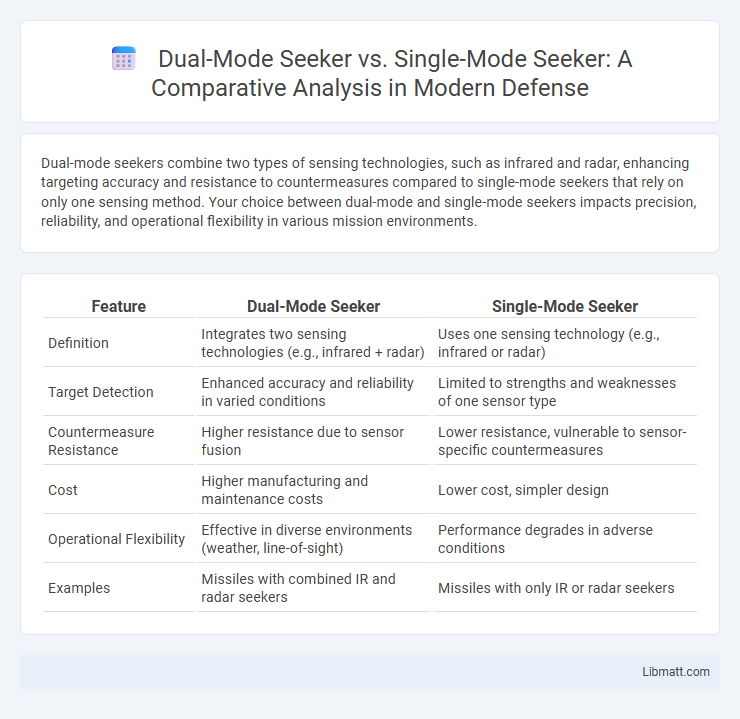Dual-mode seekers combine two types of sensing technologies, such as infrared and radar, enhancing targeting accuracy and resistance to countermeasures compared to single-mode seekers that rely on only one sensing method. Your choice between dual-mode and single-mode seekers impacts precision, reliability, and operational flexibility in various mission environments.
Table of Comparison
| Feature | Dual-Mode Seeker | Single-Mode Seeker |
|---|---|---|
| Definition | Integrates two sensing technologies (e.g., infrared + radar) | Uses one sensing technology (e.g., infrared or radar) |
| Target Detection | Enhanced accuracy and reliability in varied conditions | Limited to strengths and weaknesses of one sensor type |
| Countermeasure Resistance | Higher resistance due to sensor fusion | Lower resistance, vulnerable to sensor-specific countermeasures |
| Cost | Higher manufacturing and maintenance costs | Lower cost, simpler design |
| Operational Flexibility | Effective in diverse environments (weather, line-of-sight) | Performance degrades in adverse conditions |
| Examples | Missiles with combined IR and radar seekers | Missiles with only IR or radar seekers |
Introduction to Seeker Technologies
Dual-mode seeker technology integrates two distinct sensor types, such as infrared and radar, enhancing target acquisition accuracy and resistance to countermeasures compared to single-mode seekers, which rely solely on one sensor type. This hybrid approach allows missiles to operate effectively in diverse environmental conditions and complex threat environments, offering superior tracking reliability. Your weapon system's performance can be significantly improved by adopting dual-mode seekers, which provide enhanced situational awareness and target discrimination capabilities.
Understanding Single-Mode Seekers
Single-mode seekers operate using a single type of sensor, such as infrared or radar, to detect and track targets, offering specialized performance in specific environments. These seekers provide high accuracy and reliability when conditions favor their sensing modality but may face limitations in adverse weather or countermeasure scenarios. The simplicity and focused design of single-mode seekers often result in lower cost and reduced system complexity compared to dual-mode seekers.
Dual-Mode Seekers: An Overview
Dual-mode seekers combine multiple sensing technologies, such as infrared and radar, to enhance target detection accuracy and resistance to countermeasures compared to single-mode seekers. These advanced seekers improve engagement success in complex environments by providing complementary data that enhances tracking reliability and target discrimination. Integration of dual sensors allows for robust performance in diverse weather and battlefield conditions, ensuring higher mission effectiveness.
Key Differences: Single-Mode vs Dual-Mode Seekers
Single-mode seekers utilize a single type of sensor, such as infrared or radar, providing targeted tracking capabilities but limited adaptability in complex environments. Dual-mode seekers integrate two complementary sensor types, enhancing target acquisition accuracy, resistance to countermeasures, and operational flexibility. This combination allows dual-mode seekers to perform reliably across diverse weather conditions and against stealth technologies, surpassing the limitations inherent in single-mode systems.
Performance Comparison: Accuracy and Reliability
Dual-mode seekers combine infrared and radar technologies, enhancing accuracy and reliability by providing complementary targeting data and improved resistance to countermeasures compared to single-mode seekers that rely on one sensor type. This integration allows dual-mode seekers to better maintain lock in complex environments, increasing mission success rates and reducing false targets. Your choice of seeker can significantly impact weapon effectiveness, particularly in environments with heavy electronic interference or low visibility.
Cost and Complexity Analysis
Dual-mode seekers integrate multiple sensor technologies, such as infrared and radar, increasing the initial development and manufacturing costs compared to single-mode seekers that utilize a single sensor type. The complexity of dual-mode seekers requires advanced signal processing, calibration, and integration efforts, which contribute to higher system maintenance and operational expenses. Although the upfront investment is greater, dual-mode seekers offer enhanced target detection and tracking capabilities, potentially reducing overall mission costs through improved accuracy and reduced collateral damage.
Operational Scenarios and Applications
Dual-mode seekers excel in complex operational scenarios requiring enhanced target discrimination and resilience against countermeasures, combining infrared and radar guidance to ensure precision in contested environments. Single-mode seekers, relying on one type of sensor, are suitable for simpler applications with predictable conditions and fewer electronic threats. Your choice between dual-mode and single-mode seekers should consider mission complexity, threat level, and environmental factors to optimize targeting accuracy.
Technological Advancements and Innovations
Dual-mode seekers integrate both infrared and radar guidance systems, enhancing target detection accuracy and resistance to countermeasures compared to single-mode seekers that rely on a single detection method. Innovations in sensor fusion algorithms and signal processing have significantly improved the real-time data interpretation capabilities of dual-mode seekers, enabling superior target discrimination in complex environments. Technological advancements in miniaturization and materials have also increased the reliability and operational range of dual-mode seekers, making them more effective in modern defense applications.
Challenges and Limitations
Dual-mode seekers face challenges in integrating and synchronizing multiple sensor types, leading to higher system complexity and increased production costs compared to single-mode seekers. The weight and power consumption of dual-mode systems can limit their deployment on smaller platforms, restricting operational flexibility. Your choice between dual-mode and single-mode seekers should carefully consider these limitations against mission requirements and budget constraints.
Future Trends in Seeker Technology
Future trends in seeker technology emphasize the development of dual-mode seekers that integrate infrared and radar capabilities, significantly enhancing target detection accuracy and resistance to countermeasures compared to traditional single-mode seekers. These advanced seekers utilize sensor fusion algorithms and AI-driven signal processing, enabling your defense systems to operate effectively in complex electronic warfare environments. Continuous innovations in miniaturization and multi-spectral imaging are expected to further expand the operational versatility and precision of dual-mode seekers in upcoming missile guidance systems.
dual-mode seeker vs single-mode seeker Infographic

 libmatt.com
libmatt.com